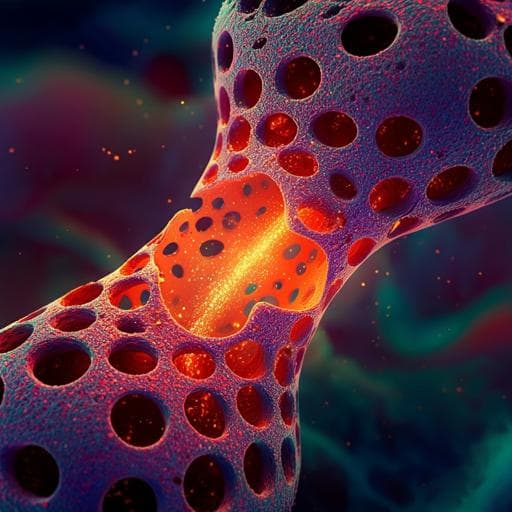
Chemistry
Catalytically-active porous assembly with dynamic pulsating motion for efficient exchange of products and reagents
S. Wu, L. Huang, et al.
Discover the groundbreaking development of a porous catalyst by researchers Shanshan Wu, Liping Huang, Yu Hou, and others, featuring 'breathing' capabilities driven by thermal stimuli. This innovative design enhances the efficiency of chemical reactions through a dynamic exchange mechanism, paving new paths in catalytic technology.
~3 min • Beginner • English
Introduction
In nature, enzymatic reactions modulated by various effects with continuously trapping reactants and releasing products in well-defined spaces, such as photosynthesis, are of great significance to achieve vital movements in living organisms. Inspired by these systems, artificial catalysts with specific apertures have been developed to promote proximity effects by increasing the local concentration of substrates. Additionally, their catalytic activity can be controlled by altering the environment around active centers in response to external triggers. However, continuous uptake of reagents to exchange products in the confined active space for efficient product turnover remains challenging. Most porous structures are based on rigid and robust pores, where products can occupy the cavity and obstruct subsequent effective collisions. Therefore, artificial catalysts that enable dynamic uptake of reagents to substitute products in hollow apertures by external triggers for vital reactions are highly desirable. Spontaneous assembly of small molecular modules driven by noncovalent interactions is key to creating stimuli-responsive dynamic devices. Expansion of transient states facilitates exchange of objects due to enhanced entropy in the aperture while subsequent contraction accelerates effective collision between reagents. Nevertheless, transient pores based on noncovalent interactions can be too delicate to ensure effective exchange. Aromatic rod amphiphiles composed of conjugated carbon and hydrophilic dendritic segments readily aggregate into porous structures with hydrophobic characteristics, suitable as defined scaffolds for organic catalysis. Introduction of active atoms such as nitrogen into conjugated carbon substrates can serve as active sites for effective collision within aromatic apertures. Building on these insights, the authors report a tubular catalyst with reversible contraction–expansion assembly for efficient exchange of products and reagents. This pulsating transition is achieved by introducing thermo-responsive alkyl blocks into pyridine-based aromatic amphiphiles, enabling reversible stacking from contracted trimeric to inflated hexameric macrocycles. The contracted tubules catalyze a nucleophilic aromatic substitution reaction via pyridine-lined walls; expansion blocks active sites but facilitates product–reagent exchange, ensuring continuous turnover. This regulable modification of porous tubules for efficient exchange provides a new approach to constructing dynamic catalysts.
Literature Review
The study builds on prior work demonstrating: (1) enzymatic and artificial catalysts operating in confined spaces to increase local substrate concentrations and control activity via external triggers; (2) self-assembled porous systems and dynamic nanostructures (e.g., amphiphilic dendrons, helical polymers, supramolecular assemblies) that recognize and process organic molecules; (3) the role of nitrogen or metals doped into carbon substrates as active sites in catalysis; and (4) supramolecular catalysts capable of product release and reassembly. The authors reference examples including self-assembled nanoreactors and stimuli-responsive systems, selective adsorption and release of organic pollutants by mesoporous materials, chiral recognition of fullerenes by helical polymers, and supramolecular catalysts that disassemble/reassemble to regulate catalysis. These works motivate a need for robust, stimuli-responsive porous catalysts that can dynamically exchange reagents and products while maintaining catalytic function.
Methodology
Molecular design: Two bent-shaped pyridine-containing aromatic amphiphiles were synthesized with thermo-responsive terminal alkyl chains of different lengths and hydrophilic oligoether dendrons at the apex (compounds 1 with decyl chains and 2 with butyl chains). The nitrogen atoms are positioned to line the inner pore surfaces upon assembly.
Assembly and structural characterization: Aqueous solutions (typically 0.01 wt% for microscopy, 0.02 wt% for XRD) of 1 and 2 were prepared. Transmission electron microscopy (TEM) was performed by depositing a drop of solution on graphene-supported films, drying at ambient conditions, and imaging at 80 kV (JEM ARM 200F). Scanning transmission electron microscopy (STEM) with a probe aberration corrector was used to measure internal diameters. For diameter assessment in stained samples, membranes were transferred to carbon-coated grids and stained with 0.1 wt% uranyl acetate prior to TEM. Two-dimensional X-ray diffraction (2D XRD) of thin membranes determined lattice parameters and stacking arrangements.
Spectroscopy: UV–vis absorption and fluorescence spectra were acquired in water versus ethanol to infer aggregation modes (H-type vs J-type). Fourier transform infrared (FTIR) spectroscopy (ATR mode) was used to probe interactions with thiol (S–H stretch) and to assess thermally induced alkyl chain order–disorder transitions via CH2/CH3 stretching bands. Temperature-dependent FTIR monitored changes at 25 and 60 °C.
Catalysis assays (SNAr): A model nucleophilic aromatic substitution between 1,3-dinitro-4-chlorobenzene (R1, 0.014 mmol) and 1-octanethiol (R2, 0.016 mmol) was conducted in water at room temperature with catalyst 1 or 2 (0.0028 mmol). Reactions were stirred 2 h in air. After completion, the mixture was evaporated, redissolved in acetonitrile, and analyzed by HPLC (C18, acetonitrile mobile phase, 1.0 mL/min, 254 nm). Retention times: R1, tR = 3.2 min; product, tR = 5.4 min.
Adsorption/encapsulation measurements: Uptake of R1, 4-methoxybenzenethiol (R3), or product by tubules 1 or 2 was quantified by mixing tubule (1.0 mg) with solute (R1 0.6 mg, R3 0.4 mg, or product 1.0 mg), sonicating 30 min at room temperature, ultrafiltration, and measuring residual filtrate concentrations by UV–vis (R1 λ = 236 nm; R3 λ = 238 nm; product λ = 332 nm). Encapsulation efficiency (%) = (C0 − C∞)/C0 × 100.
Thermal response and cycling: To induce expansion in 1, samples were heated to 60 °C to melt decyl chain crystallinity (confirmed by FTIR shifts and optical spectra changes). TEM/XRD characterized dimensions and lattice at 60 °C (expanded state). For catalytic cycling with pulsation, reactions were initiated at 60 °C to load reagents in the expanded state, then cooled to room temperature to catalyze. Post-reaction, heating to 60 °C facilitated exchange of product with fresh reagents, monitored by time-resolved HPLC sampling from a dialysis setup. Multiple heating–cooling cycles (five cycles) were conducted to assess recyclability and structural integrity (supported by TEM/XRD).
Key Findings
- Self-assembly and pore structures: Compound 1 forms tubules via stacking of trimeric macrocycles (contracted state), whereas compound 2 forms inflated tubules via hexameric macrocycles. TEM/STEM from 0.01 wt% aqueous solutions showed parallel wall spacing of 4.2 nm for 1 and 6.5 nm for 2 (TEM), with internal diameters of 2.5 nm (1) and 4.1 nm (2) (STEM). 2D XRD of 1 displayed hexagonal ordering with lattice parameter 6.0 nm and equidistant reflections assignable to 3D hexagonally ordered tubular crystals; calculated molecules per unit cell ≈ 3.1 (trimer-based). 2 showed equatorial diffraction spacing of 8.3 nm (intercolumnar distance) and ≈ 6.4 molecules per unit cell (hexamer-based).
- Aggregation modes: Optical spectra indicated 1 exhibits blue-shifted absorption and fluorescence quenching in water vs ethanol (H-type, face-to-face stacking), while 2 shows red-shifted absorption and enhanced fluorescence (J-type, side-by-side overlapped stacking).
- Catalytic performance (SNAr in water, RT): Catalyst 1 achieved high conversion up to 77% under ambient conditions. Catalyst 2 showed no detectable reaction despite porosity, attributed to blockage of pyridine active sites by flexible butyl chains in hexameric walls.
- Reagent–catalyst interactions: FTIR S–H stretching band of R2 shifted from 2564 to 2337 cm−1 in presence of 1, evidencing strong interaction (hydrogen bonding/electrostatic) between thiol and exposed pyridines. No shift with 2, confirming blocked sites.
- Adsorption behavior: Tubule 2 (inflated pores) exhibited higher equilibrium uptake for hydrophobic reagent and product than 1 and a greater difference in adsorption between reagent and product, favoring exchange upon expansion (quantitative trend shown; specific values not provided in main text).
- Thermal response of 1: Heating above 60 °C melted decyl chain crystallinity (FTIR CH stretches shifted to higher frequency and broadened). Optical absorption red-shifted from 320 to 340 nm with increased fluorescence, indicating transition from H-type to fully overlapped J-type assemblies. At 60 °C, stained TEM showed expansion to external diameter ~8.5 nm and inner diameter ~4.2 nm; XRD indicated 2D hexagonal columnar structures with lattice parameter 7.0 nm and ≈ 6.3 molecules per unit cell (hexamer-based). The expansion–contraction was reversible upon heating–cooling cycles.
- Enhanced loading and catalysis via pulsation: Upon heating, encapsulated R1 within 1 increased by ~30% due to expanded aperture. Cooling back to room temperature (contracted catalytic state) yielded improved conversion up to 89%.
- Product–reagent exchange and recyclability: After reaction completion, heating to 60 °C promoted release of product and uptake of fresh reagents, verified by time-resolved HPLC. Ultrafiltration enabled product collection. The catalytic activity and tubular structure were maintained over at least five pulsation cycles (first recycle without heating treatment), showing high efficiency, recyclability, and reusability. Tubule 1 also catalyzed SNAr reactions with various thiols, indicating broader applicability.
Discussion
The study addresses the challenge of continuous reagent uptake and product exchange in confined catalytic spaces by engineering a supramolecular tubule that switches between a catalytically active contracted state and an expanded exchange state via a thermal trigger. In the contracted, trimer-based tubules of compound 1, pyridine sites line a super-hydrophobic interior, concentrating hydrophobic reagents and enabling strong interactions (e.g., thiol S–H band shift) that promote nucleophilic aromatic substitution. Expansion to the hexamer-based state upon heating blocks pyridine sites (deactivating catalysis) but increases pore size and entropy, which enhances encapsulation of fresh reagents and release of products. This pulsating mechanism allows sequential cycles: expansion to exchange, contraction to react, thereby ensuring continuous turnover. The finding that higher temperature transiently deactivates the catalyst contrasts with conventional catalysts that accelerate with heat, highlighting the importance of dynamic structural control. The robust, reversible assembly endowed with selective hydrophobic recognition and switchable access to active sites demonstrates a design principle for dynamic heterogeneous catalysts that emulate aspects of enzymatic turnover in confined spaces.
Conclusion
A thermo-responsive supramolecular tubular catalyst was developed that undergoes reversible contraction–expansion between trimeric and hexameric macrocycle stacks. The contracted, pyridine-lined tubules (compound 1) efficiently catalyze SNAr reactions in water, while thermal expansion deactivates catalysis yet facilitates the exchange of products and reagents. This pulsating behavior enables high conversion (up to 89%), selective uptake/release, and stable recyclability over multiple cycles without structural degradation. The work introduces a generalizable strategy for dynamic porous catalysts with regulable pores to maintain continuous product turnover. Potential future directions include extending the concept to other reaction classes and active site chemistries, integrating alternative stimuli (e.g., light, pH, redox) to control pulsation, and optimizing pore architectures and alkyl chain chemistries for tunable selectivity and kinetics.
Limitations
The demonstrated catalysis focuses on a model SNAr reaction in aqueous media and primarily evaluates one thermo-responsive system (compound 1) with decyl chains; generality across diverse reaction types, solvents, and operating conditions remains to be established. Catalyst deactivation at elevated temperature, while functional for exchange, could limit applicability where thermal acceleration is desired. Quantitative adsorption and kinetic parameters are largely provided in supplementary data; mechanistic details at the molecular level (e.g., exact binding geometries and transition states) are inferred rather than directly observed. Recyclability was demonstrated over five cycles; longer-term stability and performance under continuous flow were not assessed.
Related Publications
Explore these studies to deepen your understanding of the subject.







